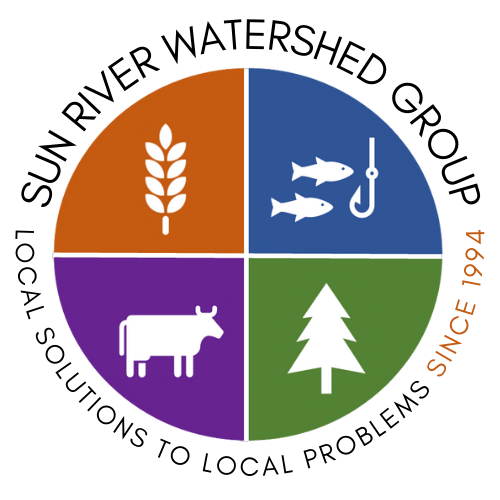Five Bullet Points of Appreciation for Federal Partners
By Tracy Wendt, Executive Director of SRWG
When I heard many of our federal partners were requested to report on their top 5 accomplishments from the previous week, I decided to use my turn at the SRWG blog space to make sure our readers know just how much our federal partners contribute to SRWG and our mission to protect and restore the resources of the Sun River watershed and its communities.
1. PROVIDE FUNDING. Did you know that since 2018 SRWG has been awarded $2,554,690 in federal grants and funding agreements, mostly from the US Bureau of Reclamation and Bureau of Land Management (BLM)? We rely on this funding to run our programs, like water quality, water management + stream gages, as well as to implement projects like the Muddy Creek Restoration and Habitat Resilience project, currently in design. Without grant administration support from Kelly, Matt, Beesan, Cathryn, Robin, Cat, Stephanie, and the rest in Denver, Billings, and Lewistown, we’d never be able to access these funding opportunities…And I’d never get a Federal Financial Report (FFR) submitted correctly without their help!
2. MENTORING. We get help from our federal partners out in the field, too. Here I specifically have to give a shout out to Bonny Richard from BLM. Bonny spent days helping a SRWG Big Sky Watershed Corps member, recently trained on wetland delineations, get practical field experience performing her first delineation with Bonny’s mentorship. Bonny has also helped our past Montana Conservation Corps intern learn to build low-tech restoration structures and set photo points for project monitoring. Bonny was a presenter at last fall’s MWCC and SRWG watershed tour. I always know I can count on her for support and to help me do my job better. If you ever get the chance to spend a day with Bonny, you’re going to learn a lot! And there are so many more federal folks like Bonny who help SRWG every year - we appreciate you all.
3. INFORMATION ABOUT WEATHER, FLOODING + DROUGHT. SRWG and other partners rely on long-range weather forecasts and climate information from the National Oceanic + Atmospheric Administration (NOAA) and the National Weather Service. All of this information is key to helping irrigation managers make decisions, engineers to develop project designs, fish and wildlife management decisions, flood warning, drought preparedness, and helping those who recreate in our area plan their trips. Last summer, the Montana Department of Natural Resources and Conservation (DNRC) installed a new stream gage on Elk Creek, and now federal partners are helping get it set up for flood warning. Textbook partnership, in action!
4. STREAM GAGES. There is an elaborate system of stream gages across the Sun River watershed. Some are operated by private entities, like SRWG, or by state agencies, like DNRC, and many are operated and maintained by USGS or the Bureau of Reclamation. Each gage is important and together they provide a full picture of stream flow trends and conditions necessary for irrigators, fish and wildlife managers, municipalities, and folks who just want to float or fish.
5. COLLABORATION. So many federal employees participate in SRWG working groups, I couldn’t begin to name them all. That’s where we bring everything together – the information, the funding, and the field work. SRWG’s projects are identified through collaborative working groups that meet regularly and are made up of state and federal employees as well as private citizens. We focus on water quality and water management mostly, but also occasionally have meetings for fisheries and wildlife or other natural resource concerns. SRWG also partners with the USFS to control noxious weeds. SRWG has worked with the Natural Resources Conservation Service (NRCS) field offices to provide financial support for irrigation efficiency projects, and hopefully soon for support to deter grizzly bears on farms and ranches.
There’s so much more, but I’m out of bullet points. Thank you to our federal partners. You are our colleagues, friends, family, and community. We couldn’t do all we do without all of you.

